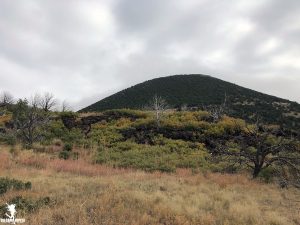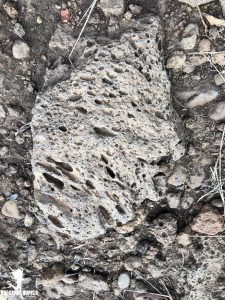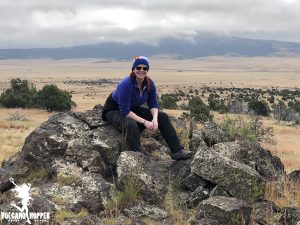
Vital Stats
Name: Capulin
Type: Cinder Cone
Eruption Status: Extinct
Last Eruption: Approximately 60,000 years ago
Location: 36.7811° N, 103.9695° W
Northeastern New Mexico; Raton-Clayton Volcanic Field
Capulin volcano has 4 lava flows – three of which are absolutely massive. They each started from a vent at the base of the volcano, which has left the stunning cone shape intact. As we waited for the clouds at the summit to lift, we decided to take a hop down the Lava Flow Trail.
This trail is a 1 mile loop through the second lava flow. It only scratches the surface; this flow extends over 2 miles down toward Highway 87! We were anxious to get our boots on the ground and go exploring. So off into the silent, misty morning we went.
Most cinder cones are formed when ground water trickles down and mixes with the basaltic magma below. It turns into a type of lava soup: liquid and runny. As the new soup travels further down into the earth, it gets closer to the mantle. It heats up in the blink of an eye and – whoosh! – flashes into steam. The steam expands and explodes, blowing a hole into the rock above it. The lava soup splashes out of the new hole. As it cools, the lava forms cinders that pile on top of each other to form a cone. Since the explosion has opened some new holes in the ground, that creates a way for the magma to bubble up and ooze out over the ground in some pretty spectacular lava flows.
Basalt is usually what I’d expect to see on a hike like this one. And we come across vast stretches of the black lava, bunched up into towering hills in places. But over the years the lava has oxidized, similar to the way an old car rusts. So along with the black chunks of lava, we saw all manner of reds, browns, and golds. It was stunning.

What did stop me dead in my tracks was a chunk of andesite right off the side of the trail. Andesite is much less runny than basalt (think peanut butter versus honey), and that usually causes it to be much more explosive. The sheild volcano just to the south of Capulin has quite a bit of andesite on its slopes. This was very surprising to learn. We think of sheild volcanoes as having more effusive eruptions with their basaltic magma. But this andesite showed us that Capulin and the surrounding mountains may have had an ornery streak; their eruptions may have packed more of a punch than your typical cinder cone eruption. Volcanoes are always full of surprises! And I love how they’ll tell you their stories if you have your eyes open.
We continued down the trail and came across huge pieces of pumice. They were extremely light if you picked one up. And they were scarred with incredible holes where gas in the magma had escaped from them. They looked as if they had been shredded. Confirmation that this volcano had some serious spunk.

Coming around the bottom of the loop, we paused at the Sierra Grande overlook. Sierra Grande is the shield volcano I previously mentioned. It sits 10 miles to the south of Capulin. That morning, its summit was hidden in the clouds. But we could see the gently sloping shape like an upside down shield or bowl. With the clouds, it reminded me of Mauna Loa in Hawaii.
This trail is not only packed with amazing geological formations, but with life. We spotted deer tracks and mountain lion prints in the mud. A lizard darted back and forth between the rocks. Trees and wildflowers covered everything and most were starting to turn vivid shades of color with the encroaching autumn. In some places, the foliage was so thick that you’d never know you were walking on an ancient lava flow.
My dad and I have gone on a lot of backcountry hikes together. The most important thing I think he ever taught me is that it’s important to be aware of your surroundings, but it’s also important to look where you’re stepping. You might find the most amazing things at the toe of your hiking boots. And we had a few amazing finds!
Volcanoes are masters of creation. Not only do they have a knack for creating land, magnficient formations, fertile ground, etc. but they will occasionally create gemstones! Olivine – also known as peridot – is one of the most common. As we walked, I spotted an unusual piece of lava. As I picked it up and examined it, I realized that there was a garnet embedded in the heart of the lava. A few steps later, and my partner in crime found a piece of lava with green olivine crystals glittering inside of it. Stunning!
But the clouds have broken at the summit. Now’s our chance! We wrap up our hike and hop in the car. It’s time to head to the summit!
Want pictures and videos? Hop over to our Facebook page to see more!

Next Up: Capulin’s Summit Crater
Copyright © 2018 Volcano Hopper. All rights reserved.



I was looking through some of your posts on this site and I believe this internet site is very instructive! Keep on putting up.
Thanks to the excellent guide
You’re welcome! I hope you find it useful.